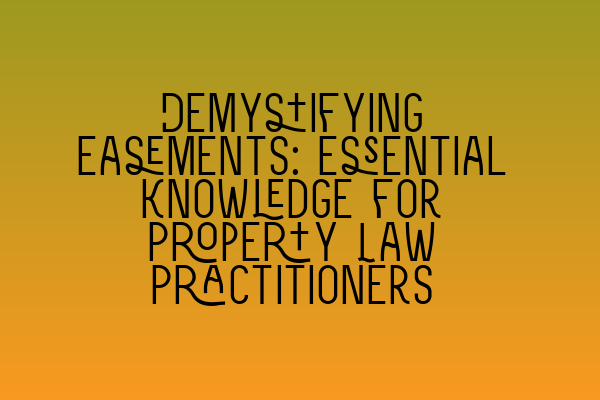Demystifying Easements: Essential Knowledge for Property Law Practitioners
Welcome to the SQE Property Law & Land Law blog! In today’s post, we will be demystifying easements and discussing their importance in property law. As a property law practitioner, it is crucial to have a solid understanding of easements and their implications in order to provide the best advice and services to your clients.
What is an Easement?
An easement is a legal right that allows one party (the dominant tenement) to use another party’s property (the servient tenement) for a specific purpose. It grants certain rights and access to the dominant tenement, while imposing restrictions on the servient tenement.
Examples of easements include a right of way, a right to light, or a right to use someone else’s land for drainage or utilities. These rights are not ownership interests, but rather a right to use the land for a particular purpose.
The Creation of Easements
There are several ways in which an easement can be created:
- Express Grant: An easement can be created by an express grant when the owner of the servient tenement grants the easement to the owner of the dominant tenement through a written agreement.
- Implied Grant: An easement can also be created through implication by the actions and intentions of the parties involved. For example, if a property is sold with an existing right of way, the easement is implied.
- Prior Use: If the dominant and servient tenements were previously owned by the same person and were later separated, the right to use the servient tenement may be implied through prior use.
- Prescription: In some cases, an easement can be acquired through prescription. This means that the dominant tenement has continuously and openly used the servient tenement for a specific period of time, usually 20 years.
It is important to carefully review the circumstances and legal documentation to determine the validity and creation of an easement in a specific case.
Types of Easements
There are various types of easements that property law practitioners should be familiar with. Some common types include:
- Right of Way: This grants the dominant tenement the right to pass through the servient tenement.
- Right to Light: This ensures that the dominant tenement has sufficient natural light access.
- Right to Drainage: This allows the dominant tenement to drain water onto the servient tenement.
- Right to Support: This ensures that the dominant tenement receives sufficient support from the servient tenement.
Each type of easement has its own legal requirements and implications, so it is essential to thoroughly understand the specific easement in question to provide accurate advice to clients.
Enforcement and Disputes
Enforcement and potential disputes surrounding easements often arise in property law. It is essential to be aware of the following when dealing with easements:
- Registering Easements: It is advisable to register easements with the Land Registry to create a legally binding record.
- Dispute Resolution: In the event of a dispute, it may be necessary to seek legal remedies such as an injunction or damages.
- Modifying or Extinguishing Easements: Easements can be modified or extinguished under certain circumstances, such as through the mutual agreement of the parties involved or by a court order.
Resolving disputes and ensuring the proper enforcement of easements requires careful consideration of the legal principles and case precedents relevant to each specific situation.
Conclusion
Easements play a vital role in property law, and as a property law practitioner, it is crucial to have a comprehensive understanding of easement creation, types, enforcement, and disputes. Demystifying easements will enable you to provide accurate advice to clients and effectively represent them in any related legal matters.
If you are studying for the SQE 1 or SQE 2 exams, be sure to check out our related articles:
- SQE 1 Practice Exam Questions
- SQE 1 Practice Mocks FLK1 FLK2
- SQE 2 Preparation Courses
- SQE 1 Preparation Courses
- SRA SQE Exam Dates
Stay tuned for more informative articles on property law and land law from SQE Property Law & Land Law. If you have any questions or need legal advice, feel free to reach out to our team of experienced property law practitioners.
